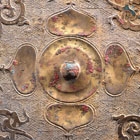J.J. Lally & Co., Oriental Art / New York City, New York
MenuPast Exhibition
Bronze and Gold in Ancient China
March 24 - April 12, 2003
11.
A BRONZE ‘DRAGON AND PHOENIX’ MIRROR
Warring States Period, 4th/3rd Century B.C.
finely cast in flat relief with two pairs of leaping dragons with contorted bodies and long, curling tails, each with head turned sharply back and legs extended in a lively symmetrical pose, alternating with four phoenix birds standing on the tips of four plain recessed petal motifs, all on a very finely detailed ground of scroll-filled lozenge motifs and fine dotted lines in a repeating grid reminiscent of woven textile, filling the main frieze around the small loop rising from a plain recessed medallion in the center, with sixteen inward-facing arcs linked together to form a wide border around the rim, the surface showing thin yellowish-brown patination with a few scattered spots of red and green corrosion, the border with encrusted malachite green and cuprite red corrosion continuing onto the plain back.
Diameter 7 3⁄8 inches (18.7 cm)
A mirror of this type in the Cleveland Museum of Art with finely detailed background and decorated with four quatrefoils, dragons and phoenixes is illustrated by Chou in Circles of Reflection: The Carter Collection of Chinese Bronze Mirrors, Cleveland, 2000, p. 29, no. 8.
Compare also the similar mirror of related design, with four dragons, from the Calmann Collection and now in the Musée Guimet, illustrated by Delacour in De bronze, d'or et d'argent- Arts somptuaires de la Chine, Paris, 2001, pp. 205-207. The same mirror is illustrated by Watson in Ancient Chinese Bronzes, London, 1962, fig. 94a, and the author discusses this group of “Loyang type” mirrors at length on pp. 85-90. He reports that the mirrors of this type, distinguished by their lively dragon decoration and distinctive finely detailed and complex textile-weave style grounds, all have been found in Henan province, in the vicinity of ancient Loyang. He agrees with Karlgren's conclusion published in ‘Early Chinese Mirrors’, B.M.F.E.A., No. 40, 1968, pp. 85-90, that this distinctive group of mirrors was first made at the end of the 5th century B.C. and the designs went out of fashion and ceased to be made in the 3rd century B.C. at the beginning of the Han Dynasty.
